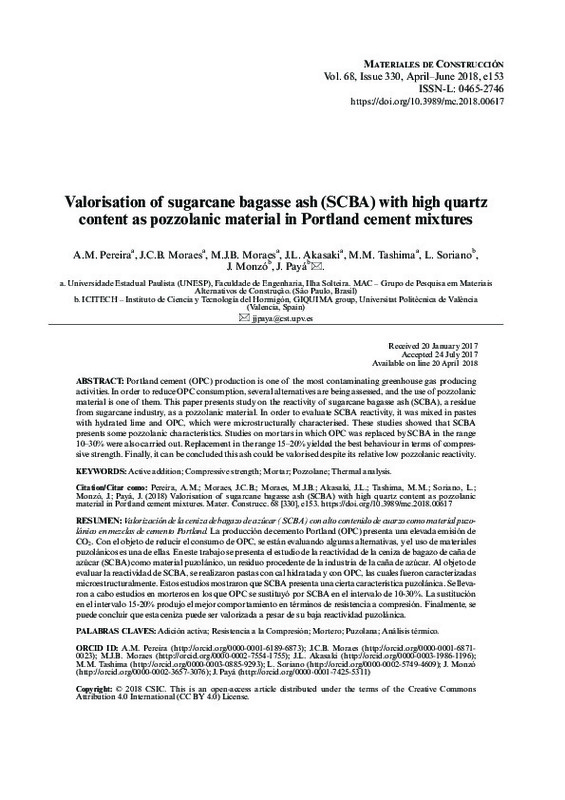1. World cement production. CEMBUREAU – The European Cement Association Website; https://cembureau.eu/media/1503/2015activityreport_cembureau.pdf
2. Guo, X.; Shi, H.; Dick, W.A. (2010) Compressive strength and microstructural characteristics of class C fly ash geopolymer. Cem. Concr. Compos. 32, 142–7.
3. Mehta, P.K.; Monteiro, P.J.M. Concrete: Microstructure, Properties, and Materials. 3rd ed. New York: McGraw- Hill, (2006).
[+]
1. World cement production. CEMBUREAU – The European Cement Association Website; https://cembureau.eu/media/1503/2015activityreport_cembureau.pdf
2. Guo, X.; Shi, H.; Dick, W.A. (2010) Compressive strength and microstructural characteristics of class C fly ash geopolymer. Cem. Concr. Compos. 32, 142–7.
3. Mehta, P.K.; Monteiro, P.J.M. Concrete: Microstructure, Properties, and Materials. 3rd ed. New York: McGraw- Hill, (2006).
4. Mo, K.H.; Alengaram, U.J.; Jumaat, M.Z. (2016) Structural performance of reinforced geopolymer concrete members: A review, Constr. Build. Mater. 120, 251-264.
5. Sharp, J.H.; Gartner, E.M.; Macphee, D.E. (2010) Novel cement system (sustainability). Session 2 of the Fred Glasser cement science symposium. Adv. Cem. Res. 22(4), 195–202.
6. BS EN 197-1. Cement – Part 1: Composition, specifications and conformity criteria for common cements. London: European Committee For Standardisation; (2011).
7. Siddique, R.; Khan, M.I. Supplementary Cementing Materials. 1st ed. Berlin: Springer, (2011).
8. Siddique, R. Waste Material and By-Products in Concrete. 1st ed. Berlin: Springer, (2008).
9. Küçükyıldırım, E.; Uzal, B. (2014) Characteristics of calcined natural zeolites for use in high-performance pozzolan blended cements. Constr. Build. Mater. 73, 229–34.
10. Tashima, M.M.; Soriano, L.; Monzó, J.; Borrachero, M.V.; Akasaki, J.L.; Payá, J. (2014) New method to assessthe pozzolanic reactivity of mineral admixtures by means pH and electrical conductivity measurementsin lime:pozzolan suspensions. Mater. Construc. 64 [316], e032.
11. Wongkeo, W.; Thongsanitgarn, P.; Chaipanich, A. (2012) Compressive strength and drying shrinkage of fly ash-bottom ash-silica fume multi-blended cement mortars. Mater. Des. 36, 655-62.
12. Lee, C.L.; Huang, R.; Lin, W.T.; Weng, T.L. (2012) Establishment of the durability indices for cement-based composite containing supplementary cementitious materials. Mater. Des. 37, 28-39.
13. Sinsiri, T.; Kroenhong, W.; Jaturapitakkul, C.; Chindaprasirt, P. (2012) Assessing the effect of biomass ashes with different finenesses on the compressive strength of blended cement paste. Mater. Des. 42, 424-33.
14. Pereira, C.L.; Savastano Jr., H.; Payá, J.; Santos, S.F.; Borrachero, M.V.; Monzó, J. (2013) Use of highly reactive rice husk ash in the production of cement matrix reinforced with green coconut fiber. Ind. Crop. Prod. 49, 88–96.
15. Paiva, H.; Velosa, A.; Cachim, P.; Ferreira, V.M. (2016) Effect of pozzolans with diferent physical and chemical characteristics on concrete properties. Mater. Construc. 66 [322], 1-12. 5
16. Hoi, L.W.S.; Martincigh, B.S. (2013) Sugar cane plant fibres: Separation and characterization. Ind. Crop. Prod. 47, 1–12.
17. Hugot, E. Handbook of Cane Sugar Engineering. 3rd ed. Amsterdam:Elsevier Science Publishers, (1986).
18. Sugarcane production. FAOSTAT – Food and Agriculture Organisation of the United Nations, Statistics Division; http://www.fao.org/faostat/en/#data/QC
19. Sugarcane production. UNICA – União da Indústria de Cana-de-Açúcar Website; http://www.unicadata.com. br/index.php?idioma=2
20. A Geração Termoelétrica com a Queima do Bagaço de Cana-de-Açúcar no Brasil. CONAB – Companhia Nacional de Abastecimento; http://www.agricultura.gov.br/assuntos/sustentabilidade/agroenergia/arquivos-termoeletrica-com-a-queima-do-bagaco-de-cana-de-acucar/termoeletrica-com-a-queima-do-bagaco-de-cana-de-acucar-no-brasil-safra-2009-2010.pdf
21. Cortez, L.A.B.; Gómez, E.O. (1998) A method for exergy analysis of sugarcane bagasse boilers. Braz. J. Chem. Eng. 15 [1].
22. Souza, A.E.; Teixeira, S.R.; Santos, G.T.A.; Costa, F.B.; Longo, E. (2011) Reuse of sugarcane bagasse ash (SCBA) to produce ceramic materials. J. Environ. Manage. 92, 2774–80.
23. Hofsetz, K.; Silva, M.A. (2012) Brazilian sugarcane bagasse: Energy and non-energy consumption. Biomass Bioenerg 46, 564–573.
24. Cordeiro, G.C.; Toledo Filho, R.D.; Tavares, L.M.; Fairbairn, E.M.R. (2009) Ultrafine grinding of sugar cane bagasse ash for application as pozzolanic admixture in concrete. Cem. Concr. Res. 39, 110–115.
25. Frías, M.; Villar, E.; Savastano, H. (2011) Brazilian sugar cane bagasse ashes from the cogeneration industry as active pozzolans for cement manufacture. Cem. Concr. Compos. 33, 490–496.
26. Fairbairn, E.M.R.; Americano, B.B.; Cordeiro, G.C.; Paula, T.P.; Toledo Filho, R.D.; Silvoso, M.M. (2010) Cement replacement by sugar cane bagasse ash: CO2 emissions reduction and potential for carbon credits. J. Environ. Manage. 91, 1864–1871.
27. Cordeiro, G.C.; Toledo Filho, R.D.; Fairbairn, E.M.R. (2009) Effect of calcination temperature on the pozzolanic activity of sugar cane bagasse ash. Constr. Build. Mater. 23, 3301–3303.
27. UNE-EN 196-5. Método de ensayo de cementos. Parte 5: Ensayo de puzolanicidad para los cementos puzolánicos. Madrid: Asociación Espa-ola de Normalización y Certificación – AENOR; (2011).
29. NBR 7215. Cimento Portland – Determinação da resistência à compressão. Rio de Janeiro: Associação Brasileira de Normas Técnicas – ANBT; (1996).
29. ASTM C-618. Standard Specification for Coal Fly Ash and Raw or Calcined Natural Pozzolan for Use in Concrete. Philadelphia: ASTM International; (2005).
31. Allahverdi, A.; Shaverdi, B.; Kani, E. (2010) Influence of sodium oxide on properties of fresh and hardened paste of alkali-activated blast-furnace slag. Int. J. Civ. Eng. 8, 304–314.
32. Yu, P.; Kirkpatrick, R.J.; Poe, B.; McMillan, P.F.; Cong, X. (1999) Structure of calcium silicate hydrate (C-S-H): Near-, mid-, and far-infrared spectroscopy. J. Am. Ceram. Soc. 82(3), 742–748.
33. Moraes, J.C.B.; Akasaki, J.L.; Melges, J.L.P.; Monzó, J.; Borrachero, M.V.; Soriano, L.; Payá, J.; Tashima, M.M. (2015) Assessment of sugar cane straw ash (SCSA) as pozzolanic material in blended Portland cement: Microstructural characterisation of pastes and mechanical strength of mortars. Constr. Build. Mater. 94, 670–677.
34. Murat, M. (1983) Hydration reaction and hardening of calcined clays and related minerals: II. Influence of mineralogical properties of raw-kaolinite on the reactivity of metakaolinite. Cem. Concr. Res. 11, 511–518.
35. Serry, M.A.; Taha, A.S.; El-Hemaly, S.A.S.; El-Didamony, H. (1984) Metakaolin-lime hydration products. Thermochim. Acta 79, 103–110.
36. Lorca, P.; Calabuig, R.; Benlloch, J.; Soriano, L.; Payá, J. (2014) Microconcrete with partial replacement of Portland cement by fly ash and hydrated lime addition. Mater. Des. 64, 535–541.
[-]









